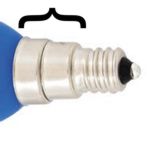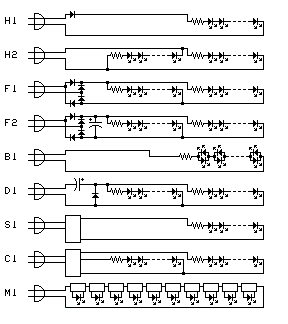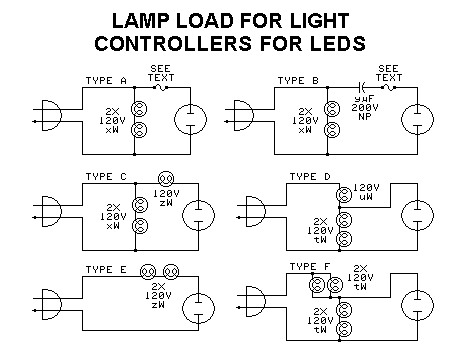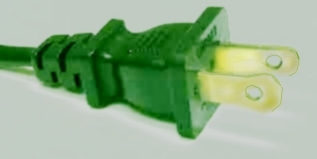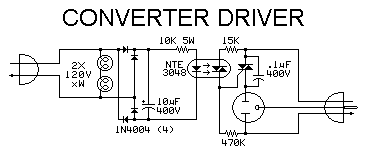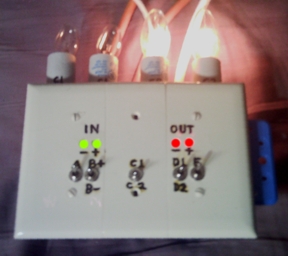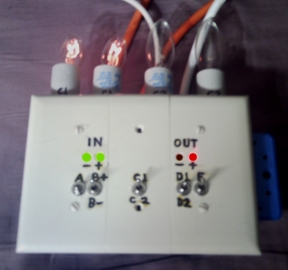What can make LEDs look to the special device like incandescent lamps?
Add a small incandescent load to the circuit:
Make a load using two incandescent lamp sockets wired in series and spliced into a
short extension cord connected between the special device and the LED light strings. The page
author used candelabra-base sockets mounted on an electrical junction box.
Be sure that all connections are well insulated, with heat-shrink tubing, electrical tape,
wire nuts, or liquid tape.
Use TYPE A for normal dimmers.
Use TYPE B if the device puts out pulsating DC (see below). May not work with all
strings.
Use TYPE C or TYPE D if the special device puts out full-wave rectified DC, but the string is
half-wave.
- If this is true, the string will be brighter on the special device
than it is in a standard power socket.
- The TYPE C load limits string current.
- The TYPE D load limits string voltage.
- The TYPE C load also needs a calculation for x in the TYPE A
Load.
Use TYPE E for strings that draw too much current and burn out too quick.
Use a fuse in either TYPE A or TYPE B that lets the string or lamp work normally, but will
blow if the string or lamp shorts out.
- No fuse is needed for TYPE C, D, or E.
Use the following tables to determine the minimum size of the incandescent bulbs needed to
use the LED strings.
| CALCULATING VALUES |
LOADED CORD
TYPE A |
|
LOADED CORD
TYPE B |
|
LOADED CORD
TYPE C |
| NEED LOAD = x/2 |
FIND CAPACITOR y |
FIND LOAD z |
One
Bulb
x
(W) |
Two
Bulbs
Each
(W) |
Hot
Bulb
Each
(Ω) |
Cap
y
(μF) |
Xc
@
60 Hz
(Ω) |
LEDs
(mA) |
Est
Load
(Ω) |
Std
Bulb
Load
(W) |
LEDs
(mA) |
Hot
Bulb
Res
(Ω) |
Bulb
volt
drop
(V) |
Std
Bulb
z
(W) |
| 4 | 2 | 7200 |
1 | 2653 | 4 | 3316 | 4 |
20 | 2880 | 57.6 | 5 |
| 5 | 2.5 | 5760 |
2 | 1326 | 8 | 1658 | 10 |
40 | 1440 | 57.6 | 10 |
| 7 | 3.5 | 4114 |
3.3 | 804 | 13 | 1005 | 15 |
60 | 960 | 57.6 | 15 |
| 10 | 5 | 2880 |
5 | 531 | 20 | 663 | 20 |
* | * | * | * |
| 12 | 6 | 2400 |
10 | 265 | 40 | 332 | 50 |
* | * | * | * |
| 15 | 7.5 | 1920 |
20 | 133 | 80 | * | * |
* | * | * | * |
| 20 | 10 | 1440 |
33 | 80 | 132 | * | * |
* | * | * | * |
| 25 | 12.5 | 1152 |
50 | 53 | 200 | * | * |
* | * | * | * |
| 30 | 15 | 960 |
100 | 27 | 400 | * | * |
* | * | * | * |
| 40 | 20 | 720 |
200 | 13 | 799 | * | * |
* | * | * | * |
| 60 | 30 | 480 |
330 | 8 | 1319 | * | * |
* | * | * | * |
* Beyond the scope of LED Christmas Strings - Use a method other than
Loaded Cord Type B or C.
| CALCULATING VALUES |
| LOADED CORD TYPES A, D, AND E |
|
LOADED CORD TYPE D WITH STRING |
| Lamp properties |
|
Series properties |
ALL |
Lower series t&t value of t |
Rate
120V
(W) |
Bulbs t and u |
Bulb t |
Bulb u |
Rate
120V
(W) |
2 Bulb Series Values |
Upper
Rated
(W) |
t to set current |
120V
(mA) |
hot
(Ω) |
cold
(Ω) |
60V
(mA) |
50V
(mA) |
120V
(W) |
120V
(mA) |
hot
(Ω) |
cold
(Ω) |
0 mA |
10 mA |
20 mA |
30 mA |
40 mA |
| 4 | 33.3 | 3600 | 450 | 16.7 | 13.9 |
4 | 2 | 16.7 | 7200 | 900 |
5 |
4 | † | † | † | † |
| 5 | 41.6 | 2880 | 360 | 20.8 | 17.4 |
5 | 2.5 | 20.8 | 5760 | 720 |
6 |
5 | † | † | † | † |
| 6 | 50.0 | 2400 | 300 | 25.0 | 20.8 |
6 | 3 | 25.0 | 4800 | 600 |
7.5 |
6 | 4 | † | † | † |
| 7.5 | 62.5 | 1920 | 240 | 31.3 | 26.0 |
7.5 | 3.75 | 31.3 | 3840 | 435 |
10 |
7.5 | 5 | 4 | † | † |
| 10 | 83.3 | 1440 | 144 | 41.7 | 34.7 |
10 | 5 | 41.7 | 2880 | 360 |
12 |
10 | 7.5 | 5 | 4 | † |
| 12 | 100 | 1200 | 180 | 50.0 | 41.7 |
12 | 6 | 50.0 | 2400 | 300 |
15 |
12 | 10 | 7.5 | 5 | 4 |
| 15 | 125 | 960 | 120 | 62.5 | 52.1 |
15 | 7.5 | 62.5 | 1920 | 240 |
20 |
15&20 | 15 | 12 | 10 | 7.5 |
| 20 | 167 | 720 | 90 | 83.3 | 69.4 |
20 | 10 | 83.3 | 1440 | 180 |
25 |
20 | 15&20 | 15 | 12 | 10 |
| 25 | 208 | 576 | 72 | 104 | 86.8 |
25 | 12.5 | 104 | 1152 | 144 |
30 |
25 | 20&25 | 20 | 15&20 | 15 |
| 30 | 250 | 480 | 60 | 125 | 104 |
30 | 15 | 125 | 960 | 120 |
40 |
30&40 | 30 | 30 | 25&30 | 25 |
| 40 | 333 | 360 | 45 | 167 | 139 |
40 | 20 | 167 | 720 | 90 |
* |
* | * | * | * | * |
* Beyond the scope of LED Christmas Strings - Use a method other
than Loaded Cord Type D.
& Between standard lamp sizes - use one of each in the series.
† Below the scope of LED Christmas Strings - Use a method other than
Loaded Cord Type D.
Calculating for load TYPE D
- The series forms a voltage divider when combined with the current drawn by
the light string(s).
- The upper lamp u wattage is adjusted so the voltage across it is 50 volts.
- The lower lamp t&t series and the string(s) should have 120 volts across
them.
- If a single-direction half-wave string is used, calculate for the direction of
current flow in the string.
- If current flows in opposite directions are unequal, calculate for the
direction with the higher current.
If the special device has a minimum wattage rating, use that in the left column of the
tables.
CAUTION: Do not exceed the Device Max power capability of the special device.
If the special device does not specify a minimum wattage, use trial and error, starting
with the largest size in the table that does not exceed the output capabilities and working
down until the special device misbehaves. Then go up at least 20 percent from the value
that made it fail, to make sure the special device does not intermittently fail.
Because the two lamps are in series, they should rarely burn out. But keep some spares,
because they may ban all incandescent lamps.
The load lamps do not need to be part of the display. They can be hidden in any
out-of-the-way place. But make sure they have ventilation air and do not touch other
materials.
This TYPE A load will be referred to as a loaded cord.
An output with this TYPE A load device connected to it will be referred to as a
loaded output.
The capacitor in the TYPE B load must be non-polarized.
Experiment with bulb z wattage in the TYPE C and TYPE D loads to make string brightness
the same as the string plugged into a standard power socket. Bulb z might not reach full
hot resistance.
